MAKING THE SWICK WORK
There are some
guidelines that make this system work smoothly.
1. When you mix up your soil, go overboard on the aeration, to the tune of up to 25% more in volume. This will assist the wicking up through the entire pot.
2. Keep the water level to 1-2" below the bottom of the pots, whether sitting on the surface or snuggled into the perlite. You want to avoid the roots sitting in water.
3. A SWICK will work best with perlite. The smaller particulate matter wicks the water up more smoothly than larger pieces, but lava rock will work well too. Once the water has begun wicking up it maintains a continuous flow on demand. If using hard pots, go with perlite.
4. Go as deep as you comfortably can. This system is designed to eliminate the stress of watering. A deeper reservoir means less frequent topping off. A shallow reservoir might need replenishing numerous times a day. If you travel regularly choose a deeper reservoir. We know of one case where the grower went away for a week and his plants didn't skip a beat.
5. If you use big pots you might want to consider lazy susans under them. Think of how easy that will make maintaining and grooming your plants.
6. Fabric pots act as additional wicking agents, pulling the water right into the matrix. If you use hard pots you need to nestle them into the perlite so that the soil comes into contact with the perlite through the drain holes.
7. After the system has set itself you will notice an eerie consistency on water draw by the plants. I have no explanation for this, but it's held consistent all through my grow. When they were ready to harvest water draw dropped by almost half about three to five days ahead. This makes it easier to prepare for harvest.
8. You can tell if the system is working by checking for wetness along the bottom of the pot. Not wringing wet, but obviously moist.
9. Roots exiting the pot can be scraped off without any damage or stress to the plant. These are only water roots. You can also leave them until you harvest and scrape them off as you reset the pot for the next planting. Incidentally, when you see those exiting roots you should expect a growth spurt to occur.
10. Consider one large SWICK for numerous plants. The plants apparently communicate with each other in much the same manner that those sharing a soil matrix will. This is a subtle thing and difficult to quantify, but plants sharing a common SWICK seem to be happier and healthier. There is so much we don't understand in this wonderful world of ours.
That's all I can think of. We have a limited amount of time to edit this, so if anyone has any other pointers, please let me know and I will edit.

 ok..thank you again..no fabric. got it..
ok..thank you again..no fabric. got it..




 Watch the roots explode.
Watch the roots explode.


